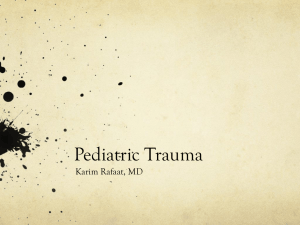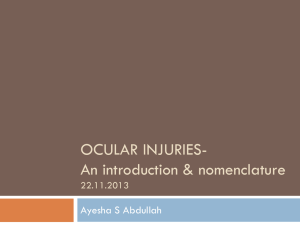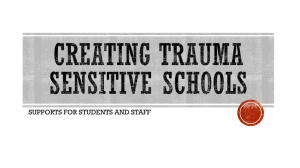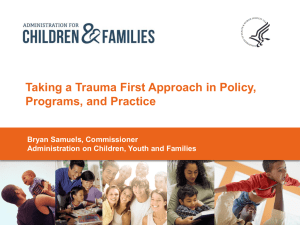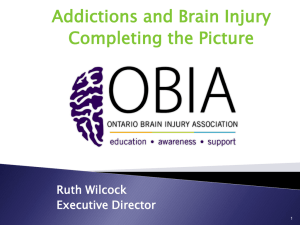Visceral Injuries in Child Abuse- ANTHONY DEROSS
advertisement
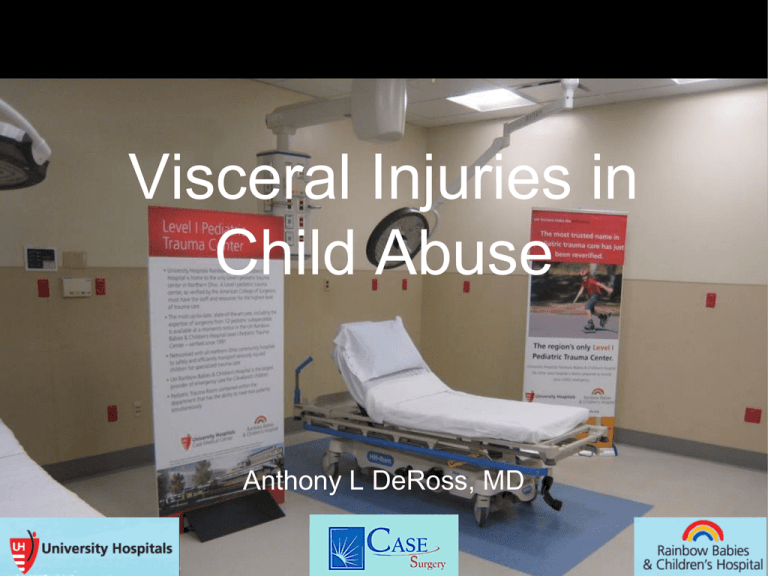
Visceral Injuries in Child Abuse Anthony L DeRoss, MD Disclosures • I have no conflicting interests to disclose. Objectives • Participants will understand current aspects of child maltreatment with physical abuse including: - Epidemiology Constellations of injuries Diagnosis Prevention Epidemiology • Definitions of abuse - Child maltreatment • Physical abuse - beatings, shaking, scalding, and biting • Neglect - omission of care, such as health care, education, supervision, protection from environmental hazards, meeting physical needs (eg, clothing or food), and emotional support, resulting in actual or potential harm Dubowitz H, Bennett S. Physical abuse and neglect of children. Lancet 2007; 369: 1891–99. Epidemiology • 436,321 substantiated cases of abuse in the US in 2010 - 78% neglect 18% physical abuse 9% sexual abuse Federal fiscal year 2010 data Child Maltreatment 2010. U.S. Department of Health & Human Services, Administration for Children and Families. 2011. Available at: http:// www.acf.hhs.gov/programs/cb/resource/child-maltreatment-2010. Epidemiology • Nationally estimated unique victims - 695,000 • Nationally estimated duplicate victims - 754,000 Federal fiscal year 2010 data Child Maltreatment 2010. U.S. Department of Health & Human Services, Administration for Children and Families. 2011. Available at: http:// www.acf.hhs.gov/programs/cb/resource/child-maltreatment-2010. Epidemiology • Victims aged birth to 1 year - highest rate of victimization 20.6 per 1,000 children (of the same age group in the national population) Federal fiscal year 2010 data Child Maltreatment 2010. U.S. Department of Health & Human Services, Administration for Children and Families. 2011. Available at: http:// www.acf.hhs.gov/programs/cb/resource/child-maltreatment-2010. Epidemiology • Gender - boys 48.5 percent girls 51.2 percent Federal fiscal year 2010 data Child Maltreatment 2010. U.S. Department of Health & Human Services, Administration for Children and Families. 2011. Available at: http:// www.acf.hhs.gov/programs/cb/resource/child-maltreatment-2010. Epidemiology • Ethnicity - Eighty-eight percent of victims were comprised of three races or ethnicities: • • • African-American (21.9%), Hispanic (21.4%) White (44.8%). Federal fiscal year 2010 data Child Maltreatment 2010. U.S. Department of Health & Human Services, Administration for Children and Families. 2011. Available at: http:// www.acf.hhs.gov/programs/cb/resource/child-maltreatment-2010. Epidemiology • Mortality - 1,560 children died from abuse and neglect Overall rate of child fatalities - 2.07 deaths per 100,000 children 79.4% of all child fatalities were younger than 4 years old Federal fiscal year 2010 data Child Maltreatment 2010. U.S. Department of Health & Human Services, Administration for Children and Families. 2011. Available at: http:// www.acf.hhs.gov/programs/cb/resource/child-maltreatment-2010. Epidemiology • Mortality - Boys had a higher child fatality rate • • 2.51 per 100,000 boys in the population 1.73 per 100,000 girls in the population 32.6% of child fatalities were attributed exclusively to neglect 40.8% of child fatalities were caused by multiple maltreatment types Federal fiscal year 2010 data Child Maltreatment 2010. U.S. Department of Health & Human Services, Administration for Children and Families. 2011. Available at: http:// www.acf.hhs.gov/programs/cb/resource/child-maltreatment-2010. Epidemiology • Perpetrators - - 81.2% of duplicate perpetrators were parents • 84.2% of these were the biological parent 6.1% were other relatives of the victim 45.2% of unique perpetrators were men 53.6% were women 36.3% of unique perpetrators were age 20-29 years 84.2% of unique perpetrators were age 20-49 Federal fiscal year 2010 years data Child Maltreatment 2010. U.S. Department of Health & Human Services, Administration for Children and Families. 2011. Available at: http:// www.acf.hhs.gov/programs/cb/resource/child-maltreatment-2010. Epidemiology • Clues suggesting abuse: - Discrepancy between story and degree of abuse - Delay in presentation - Repeated trauma in same or different EDs - Story changes between parents/guardians - History of changing doctors or hospitals - Parents/guardians respond inappropriately Epidemiology • Physical exam findings suggesting abuse: - Multicolored bruises Old scars Healing fractures Perioral injuries Perineal injuries Long bone fractures in children < 3 years old Epidemiology • Physical exam findings suggesting abuse: - Ruptured internal viscera without story of trauma Multiple SDH without skull fracture Retinal hemorrhages Bites, cigarette burns, rope marks Sharply demarcated burns/bruises Epidemiology • Specific intra-abdominal injuries and patient characteristics found in physically abused children have been described: - Pancreatic injury Hollow viscous injury TBI Mortality Young age Poor nutrition Neglect Trokel M, et. al. Patient and Injury Characteristics in Abusive Abdominal Injuries. Pediatric Emergency Care 22(10)October 2006, 700-704. Epidemiology • 2006 review of the National Pediatric Trauma Registry (1988-2001) - All children younger than age 5 Abdominal trauma Excluding MVC 664 patients Trokel M, et. al. Patient and Injury Characteristics in Abusive Abdominal Injuries. Pediatric Emergency Care 22(10)October 2006, 700-704. Epidemiology Trokel M, et. al. Patient and Injury Characteristics in Abusive Abdominal Injuries. Pediatric Emergency Care 22(10)October 2006, 700-704. Epidemiology Trokel M, et. al. Patient and Injury Characteristics in Abusive Abdominal Injuries. Pediatric Emergency Care 22(10)October 2006, 700-704. Epidemiology • Small bowel injury - specific to abuse in multiple studies increased association in children under 5 Barnes PM, et. al. Abdominal injury due to child abuse. Lancet 2005; 366: 234–35. Epidemiology • Duodenal injury - Rare in children (<5% pediatric abdominal injuries) Usually associated with high-magnitude force Most often the result of blunt trauma • • • • • • Child maltreatment MVC Bicycle crashes Falls onto an object or being crushed by an object Sports injuries ATV crashes Sowry L, et. al. Duodenal injuries in the very young: Child abuse?J Trauma Acute Care Surg. 2013;74: 136-142. Epidemiology • Retrospective study (2012) - 6 level I pediatric trauma centers All children <5 years old 1991-2011 32 children with duodenal injuries were identified in 21,542 trauma admissions • (1.5 per 1,000 admissions) Sowry L, et. al. Duodenal injuries in the very young: Child abuse?J Trauma Acute Care Surg. 2013;74: 136-142. Epidemiology Sowry L, et. al. Duodenal injuries in the very young: Child abuse?J Trauma Acute Care Surg. 2013;74: 136-142. Epidemiology Gaines, et. al. (2004) Gaines B, et. al. Duodenal Injuries in Children: Beware of Child AbuseJournal of Pediatric Surgery, Vol 39, No 4 (April), 2004: pp 600-602 Epidemiology Gaines B, et. al. Duodenal Injuries in Children: Beware of Child AbuseJournal of Pediatric Surgery, Vol 39, No 4 (April), 2004: pp 600-602 Diagnosis Diagnosis • History - Absence of explanation for the injury Changing explanations Inconsistent with the child’s developmental capabilities Delay in seeking medical care Dubowitz H, Bennett S. Physical abuse and neglect of children. Lancet 2007; 369: 1891–99. Diagnosis • History - Details should include • • • • • Previous trauma Admissions to hospital Chronic illness Adherence to treatment Family history of easy bruising or fractures Dubowitz H, Bennett S. Physical abuse and neglect of children. Lancet 2007; 369: 1891–99. Diagnosis • History - Details should include • • • • • • • Substance or alcohol abuse Mental illness Intimate partner violence Discipline practices Stressors Previous involvement of child protection services Careful documentation, ideally with photographs Dubowitz H, Bennett S. Physical abuse and neglect of children. Lancet 2007; 369: 1891–99. Diagnosis • Abdominal trauma - Accounts for substantial morbidity and mortality in abused children. • • • • • large abdomens lax abdominal musculature bruising of the abdominal wall is unusual perforation can be delayed days after the injury pancreatic pseudocysts can occur weeks or months later Dubowitz H, Bennett S. Physical abuse and neglect of children. Lancet 2007; 369: 1891–99. Diagnosis • Abdominal trauma - - Hollow organs can be ruptured by a blow or kick Solid organs (pancreas) can be injured over the spine Bleeding could result from trauma to an organ or from shearing of the vascular supply Bilious vomiting in a young child without fever or peritoneal irritation suggests a duodenal hematoma Dubowitz H, Bennett S. Physical abuse and neglect of children. Lancet 2007; 369: 1891–99. Diagnosis • Physical exam - - Classic signs and symptoms... • • • Abdominal tenderness Bruising Distention ... can be unreliable, esp in young patients. Lindberg DM, et. al., Utility of Hepatic Transaminases in Children With Concern for Abuse. Pediatrics 2013;131;268 Diagnosis • Laboratory tests... - serum amylase serum lipase serum transaminases • ... are of questionable utility. Diagnosis Lindberg DM, et. al., Utility of Hepatic Transaminases in Children With Concern for Abuse. Pediatrics 2013;131;268 Diagnosis • AST or ALT ≥ 80 IU/L - sensitivity of 83.8% specificity of 83.1% • Amylase and lipase - sensitivities and specificities 60-70% ranges, respectively Lindberg DM, et. al., Utility of Hepatic Transaminases in Children With Concern for Abuse. Pediatrics 2013;131;268 Diagnosis • Retrospective chart review • Urban Level I pediatric trauma center • 1991 and 2001 • Children younger than 6 years • Admitted with abdominal injuries • Abbreviated Injury Scale (AIS) score > 2 Wood J, et al. Distinguishing Inflicted versus Accidental Abdominal Injuries in Young Children. J Trauma. 2005;59:1203–1208. Diagnosis • Accidental injuries - high velocity • • motor vehicle crash fall from > 10 feet or low velocity • • • household trauma bicycle crash fall from < 10 feet Wood J, et al. Distinguishing Inflicted versus Accidental Abdominal Injuries in Young Children. J Trauma. 2005;59:1203–1208. Diagnosis - Inflicted trauma • • • constellation of unexplained injuries confessions by a perpetrator disclosure by the victim Wood J, et al. Distinguishing Inflicted versus Accidental Abdominal Injuries in Young Children. J Trauma. 2005;59:1203–1208. Diagnosis • 208 children identified - 203 charts available 63 were excluded because of associated neurologic injury 7 were excluded secondary to severe thoracic injury 10 abused children were excluded because there was a denial of any trauma One child was excluded because the injuries could not be classified as accidental or inflicted One child was excluded because of the difficulty in identifying a time of initial injury Wood J, et al. Distinguishing Inflicted versus Accidental Abdominal Injuries in Young Children. J Trauma. 2005;59:1203–1208. Diagnosis • The remaining 121 cases were included - 108 (89%) children with accidental trauma • • • HVA trauma occurred in 77 (63%)children LVA trauma occurred in 31 (26%) children Inflicted abdominal trauma occurred in 13 (11%) children Wood J, et al. Distinguishing Inflicted versus Accidental Abdominal Injuries in Young Children. J Trauma. 2005;59:1203–1208. Investigators found that, whether used in isolation or restricted to children with more severe injuries, the predictive value of delay to care as an indicator of abuse rose only to 67% because the overall prevalence of inflicted injury among those with abdominal injuries younger than 6 years of age was only 30% in this cohort (when the HVA injuries were excluded). Wood J, et al. Distinguishing Inflicted versus Accidental Abdominal Injuries in Young Children. J Trauma. 2005;59:1203–1208. Diagnosis • Conclusions - The presence of multiple injuries and a delay to care are associated with child abuse... but neither approaches the specificity required to rely on those features alone for a diagnosis of abuse. Wood J, et al. Distinguishing Inflicted versus Accidental Abdominal Injuries in Young Children. J Trauma. 2005;59:1203–1208. Summary • • • • Despite continued measures dedicated to prevention and diagnosis, child maltreatment remains an important public health concern. Visceral injuries associated with child maltreatment can vary but often present with recognized constellations of symptoms. A multidisciplinary approach including analysis of the patient as a whole including history (age), mechanism, and type of injury are crucial steps toward arrival at an accurate diagnosis. Clinicians must be aware of limitations in diagnostic methods. Questions Thank You


